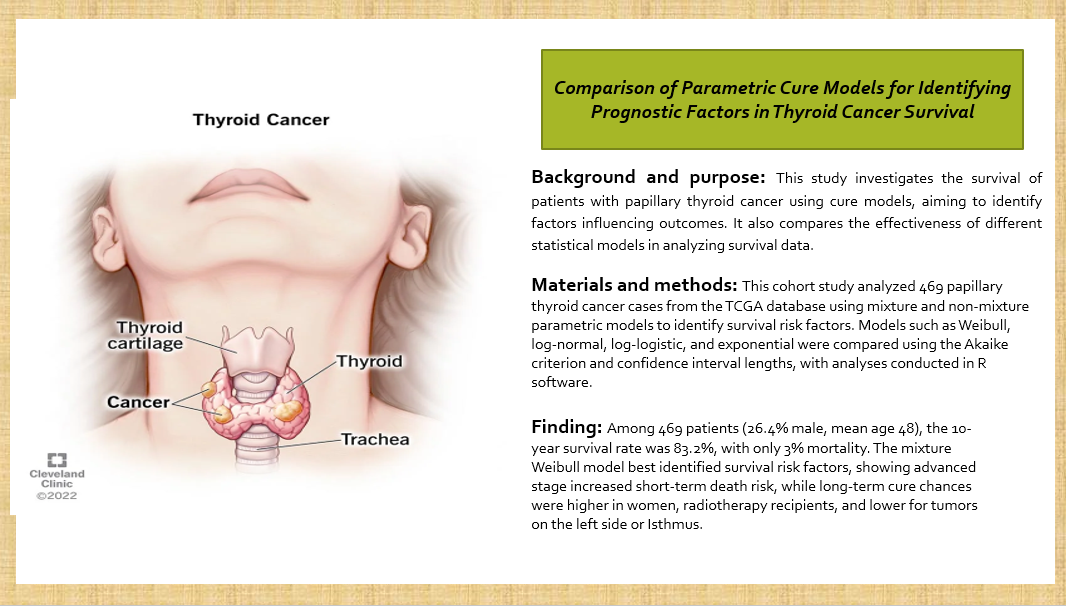Volume 35, Issue 246 (7-2025)
J Mazandaran Univ Med Sci 2025, 35(246): 83-94 |
Back to browse issues page
Download citation:
BibTeX | RIS | EndNote | Medlars | ProCite | Reference Manager | RefWorks
Send citation to:



BibTeX | RIS | EndNote | Medlars | ProCite | Reference Manager | RefWorks
Send citation to:
Dindarloo M M, Fendereski A, Kashi Z, Shabankhani B, Yazdani-Charati J. Comparison of Parametric Cure Models for Identifying Prognostic Factors in Thyroid Cancer Survival. J Mazandaran Univ Med Sci 2025; 35 (246) :83-94
URL: http://jmums.mazums.ac.ir/article-1-21317-en.html
URL: http://jmums.mazums.ac.ir/article-1-21317-en.html
Mohammad Mehdi Dindarloo 
 , Afsaneh Fendereski
, Afsaneh Fendereski 
 , Zahra Kashi
, Zahra Kashi 
 , Bizhan Shabankhani
, Bizhan Shabankhani 
 , Jamshid Yazdani-Charati
, Jamshid Yazdani-Charati 


 , Afsaneh Fendereski
, Afsaneh Fendereski 
 , Zahra Kashi
, Zahra Kashi 
 , Bizhan Shabankhani
, Bizhan Shabankhani 
 , Jamshid Yazdani-Charati
, Jamshid Yazdani-Charati 

Abstract: (691 Views)
Background and purpose: Papillary thyroid carcinoma (PTC) is the most common type of thyroid cancer and is generally associated with a favourable prognosis. However, recurrence and disease progression can occur in some patients. This study aims to evaluate the survival of patients with PTC and the factors influencing it, using statistical models to better understand the natural course of the disease and support the development of personalized treatment strategies.
Materials and methods: This cohort study included 469 patients diagnosed with papillary thyroid carcinoma between 1993 and 2013, with data extracted from the TCGA database. Parametric models were used to analyze the data and identify risk factors affecting patient survival. Various models were applied to estimate cure fractions and assess the importance of different factors, and model performance was compared using statistical criteria.
Results: Among the 469 patients studied, 124 (26.4%) were male, and the mean age was 48 ± 15.53 years. By the end of the study, 14 patients (3%) had died. The 1-, 3-, 5-, and 10-year survival rates were 98.6%, 91.3%, 83.2%, and 83.2%, respectively. The results indicated that the mixture Weibull model performed best in identifying factors affecting patient survival. An advanced disease stage was associated with a higher risk of early mortality, while female patients and those who received radiotherapy were more likely to achieve complete cure.
Conclusion: This study highlights the significance of selecting appropriate cure models for survival data analysis, emphasizing that model choice should be based on the specific characteristics of the data and the research objectives. The findings demonstrate the generally favorable prognosis of papillary thyroid carcinoma and the impact of factors such as age, gender, radiotherapy, and tumor location on patient survival, underscoring the need for personalized therapeutic approaches in this context.
Materials and methods: This cohort study included 469 patients diagnosed with papillary thyroid carcinoma between 1993 and 2013, with data extracted from the TCGA database. Parametric models were used to analyze the data and identify risk factors affecting patient survival. Various models were applied to estimate cure fractions and assess the importance of different factors, and model performance was compared using statistical criteria.
Results: Among the 469 patients studied, 124 (26.4%) were male, and the mean age was 48 ± 15.53 years. By the end of the study, 14 patients (3%) had died. The 1-, 3-, 5-, and 10-year survival rates were 98.6%, 91.3%, 83.2%, and 83.2%, respectively. The results indicated that the mixture Weibull model performed best in identifying factors affecting patient survival. An advanced disease stage was associated with a higher risk of early mortality, while female patients and those who received radiotherapy were more likely to achieve complete cure.
Conclusion: This study highlights the significance of selecting appropriate cure models for survival data analysis, emphasizing that model choice should be based on the specific characteristics of the data and the research objectives. The findings demonstrate the generally favorable prognosis of papillary thyroid carcinoma and the impact of factors such as age, gender, radiotherapy, and tumor location on patient survival, underscoring the need for personalized therapeutic approaches in this context.
Type of Study: Research(Original) |
Subject:
Biostatistics
Send email to the article author
| Rights and permissions | |
 |
This work is licensed under a Creative Commons Attribution-NonCommercial 4.0 International License. |





